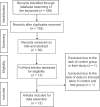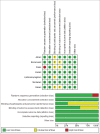Effect and Safety of Castor Oil on Labor Induction and Prevalence of Vaginal Delivery: A Systematic Review and Meta-Analysis
- PMID: 36275342
- PMCID: PMC9580580
- DOI: 10.4103/ijnmr.ijnmr_7_21
Effect and Safety of Castor Oil on Labor Induction and Prevalence of Vaginal Delivery: A Systematic Review and Meta-Analysis
Abstract
Background: Castor oil is used in some countries to induce labor, but results on its effectiveness and safety is controversial. This systematic review and meta-analysis aimed to evaluate the effect of castor oil on labor induction and prevalence of vaginal delivery along with investigating its safety.
Materials and methods: PubMed, Scopus, Web of Science, and Google Scholar were searched systematically up to September 2020. Observational studies and Randomized Clinical Trials (RCTs), which assessed the effect of castor oil on labor induction in English and Persian languages using different combinations of the related key terms and Medical Subject Headings (MeSH) terms were collected and analyzed independently by two authors. Random effect model was used for meta-analysis. The studies were included in which the Relative Risk (RR) had been reported with 95% Confidence Intervals (CIs).
Results: A total of 12 studies consisting 1653 pregnant women were included. The mean age of women who used castor oil was 24.72 years and in control group was 24.67 years. Results showed that labor induction was significantly higher in castor oil group than control group (RR: 3.27; 95% CI (1.96, 5.46)). Prevalence of vaginal delivery was 81% in the castor oil group and 69% in the control group.
Conclusions: It can be concluded that use of castor oil has positive effect on labor induction and increases the prevalence of vaginal delivery. None of the studies considered in this meta-analysis reported any serious harmful effects for the use of castor oil.
Keywords: Castor; Induced; Labor; obstetric labor; oil.
Copyright: © 2022 Iranian Journal of Nursing and Midwifery Research.
Conflict of interest statement
Nothing to declare.
Figures







Similar articles
-
Effect of Castor Oil on Cervical Ripening and Labor Induction: a systematic review and meta-analysis.J Pharmacopuncture. 2022 Jun 30;25(2):71-78. doi: 10.3831/KPI.2022.25.2.71. J Pharmacopuncture. 2022. PMID: 35837141 Free PMC article. Review.
-
Induction of Labor Using Castor Oil Cocktail - an Analysis of Real-world Data.Geburtshilfe Frauenheilkd. 2024 Sep 12;84(11):1050-1056. doi: 10.1055/a-2397-1490. eCollection 2024 Nov. Geburtshilfe Frauenheilkd. 2024. PMID: 39524031 Free PMC article.
-
Castor oil as a natural alternative to labor induction: A retrospective descriptive study.Women Birth. 2018 Apr;31(2):e99-e104. doi: 10.1016/j.wombi.2017.08.001. Epub 2017 Aug 31. Women Birth. 2018. PMID: 28838804
-
Effects of induction of labor prior to post-term in low-risk pregnancies: a systematic review.JBI Database System Rev Implement Rep. 2019 Feb;17(2):170-208. doi: 10.11124/JBISRIR-2017-003587. JBI Database System Rev Implement Rep. 2019. PMID: 30299344 Free PMC article.
-
Castor oil for induction of labor in post-date pregnancies: A randomized controlled trial.Women Birth. 2018 Feb;31(1):e26-e31. doi: 10.1016/j.wombi.2017.06.010. Epub 2017 Jul 24. Women Birth. 2018. PMID: 28750937 Clinical Trial.
References
-
- Hall HG, McKenna LG, Griffiths DL. Complementary and alternative medicine for induction of labour. Women Birth. 2012;25:142–8. - PubMed
-
- McKeon T. Castor (Ricinus communis L.) USA AOCS Press; 2016. pp. 75–112.
Publication types
LinkOut - more resources
Full Text Sources
